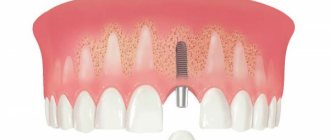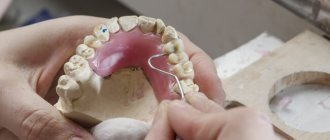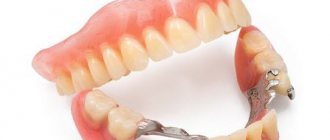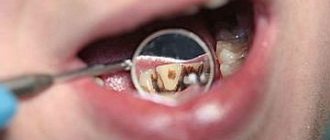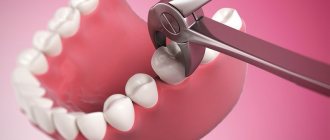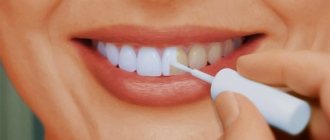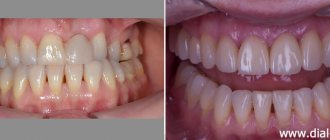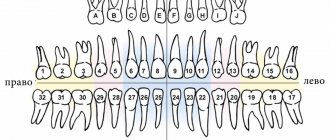The method of treating dental canals with resorcinol-formalin paste, proposed at the beginning of the last century in Germany, lasted more than 100 years. The effect of the paste is based on its mummifying and bactericidal effect on the affected dental pulp.
Due to this paste, the process of inflammation in the pulp stopped, and the paste firmly hardened and sealed the canal. It would seem that everything is fine, the pulp ceases to exist, the canal is closed.
But as it turned out, the use of resorcinol and formaldehyde in dentistry is categorically unacceptable.
To treat or remove a tooth?
Today, dental organizations and doctors are divided into two camps.
The first solve patients' problems in quick and radical ways. These are dentists from public and poorly equipped clinics who cannot provide quality treatment due to a lack of material resources or level of knowledge.
The latter are looking for all sorts of ways to maintain a full bite. They evaluate patients’ problems from the standpoint of “can they be restored or cured,” rather than offering immediate tooth extraction as the only correct solution.
Why are “rescuer” doctors the best option for patients? It's simple. Restoration work:
- guarantee long-term dental health;
- do not force you to think about implants, crowns;
- minimize pain;
- maintain the natural attractiveness of a smile;
- provide the correct bite or restore it.
Frequent concerns of patients on the topic of “treating or removing” a tooth concern:
- enamel cracks;
- fillings that burst along with the crown;
- third “wise” molars;
- resorcinated teeth.
Four problems are the “stumbling blocks” on which the opinions of dentists of the old and new schools differ. The most reasonable way in this case is to go to a well-equipped clinic or get several independent dental consultations.
Only then will the patient find answers to all his questions: is it possible to restore a cracked tooth, whether to remove wisdom teeth and resorbed teeth, or to cure them.
“One head is good, but two... more professional”
Today, the dental services market is heterogeneous. The client can contact:
- a “Soviet” municipal clinic with a minimal set of equipment and outdated treatment methods;
- to a large public clinic with decent funding and a good range of services;
- to private dental centers that are constantly developing professionally.
There are many clinics. In each, doctors work according to the algorithm recommended by their management. Policies on this issue vary greatly: some devote limited time to the patient, others sincerely care about the patient’s jaw.
The patient chooses where to be treated himself. But regardless of your decision, it's good to have some professional opinions. And based on the information received, make a decision: delete, treat or restore.
Independent opinions can easily be obtained by visiting one or two or three clinics with a good reputation and having a detailed conversation with a dentist about existing dental problems and methods for eliminating them.
It is easy to remove a tooth, but a new one will not grow. And you just need to remember this.
Prices for “retreatment” of the canals of a resorptive tooth vary from 4,000 to 6,500 rubles per tooth and depend on the “complexity” of the tooth, that is, on the number of canals in it.
Caries on a wisdom tooth: treat or remove
Many people have known since childhood that “wisdom” molars are an atavistic heritage. Then the information is laid down that these are molars that are unnecessary for a person, and they need to be removed immediately after eruption. Competent dentists today do not support this opinion.
The situation needs to be viewed from two perspectives.
- Should wisdom teeth be removed if they don’t bother me? Definitely no. Especially if the molars are paired - there is both an upper and a lower one, and also in the absence of mobility, caries and even growth in the dentition.
- Hole in wisdom tooth – treat or remove? It's a little more complicated, but there are more reasons to preserve the third molar than to extract it.
No dentist will answer the question “wisdom tooth caries – treat or remove” without examining the patient. The decision to save a molar is accompanied by an objective assessment of many factors. The doctor looks:
- The degree of damage is the number of caries lesions, their location, and the presence of other dental problems. It happens that a patient comes with “caries,” but in reality it turns out that the carious process has already gone far. And here several options are possible - pulpitis, periodontitis, cyst, wisdom tooth granuloma.
- Location under or above the gum tissue - retracted and semi-retracted teeth often bother patients, but it is not difficult to solve this problem with modern medicine.
- Quality of growth. Wisdom teeth do not always grow straight. Sometimes it interferes with chewing, injures the soft tissues of the cheek, and serves as a constant source of discomfort.
Studying all aspects of the disease, painstaking and accurate diagnosis will help the doctor make a decision on treatment and select the optimal sequence of manipulations.
New technologies guarding “wisdom”
The decision has been made - we need to treat. Often such information leads the patient to panic, expecting pain and discomfort. Don't worry. Complete painless treatment is guaranteed by modern equipment and the professionalism of the doctor.
When sanitation of the oral cavity, the dentist uses:
- Modern equipment. Installation with a bur rotation speed of 150, 300, 500 rpm with forced water-air cooling of the tip guarantees the absence of unpleasant vibration, eliminates overheating of the tooth, and almost completely eliminates pain. Allows treatment without anesthesia, but for hypersensitive and panicking patients, pain relief remains a necessity.
- High quality anesthesia. There are many options. The choice depends on the skills and knowledge of the doctor and the equipment of the clinic. You can “freeze” half of the patient’s face for 6-8 hours or deprive the patient of discomfort in the local area for 40-60 minutes, which is necessary for the treatment of wisdom tooth caries. Infiltration anesthesia - intraligamentary and intraseptal - for high-quality “freezing” is used in clinics of a high level of service. Monitoring the professionalism of dentists and their frequent training ensure full mastery of complex anesthesiological techniques.
The use of modern treatment methods makes it possible to get rid of even pulpitis of the third molar. The presence of numerous channels, their arbitrary curvature, and deep damage to the structure are not a problem for innovative technologies. Of course, the doctor will need full control of the process - high-quality x-rays, the use of a dental microscope, an apex locator, and other tools and devices.
The result of the efforts is logical: the quality of the work is excellent, and the patient’s “wise” molar is preserved.
Resorcinol-formalin method: preparatory stage
The essence of this method is to transform the pulp into a plastic-like aseptic strand, which would not be subject to dissolution under the influence of tissue microflora. Therefore, in order to avoid the development of “residual pulpitis,” the pulp must be devitalized before impregnation begins.
Filling canals using Albrecht technology is carried out in several stages. At the preparatory stage, attention is paid to filling the root canals, which were managed to pass along the entire length. Others are filled in to the extent possible. Then, to necrotize the tissue remnants of the damaged pulp, the mouths of each of them are drilled out. Three sessions are allotted for all manipulations.
At this stage, the specialist is preparing the solution. Start making a paste with 5 drops of formaldehyde, for which a glass plate is used. Afterwards, resorcinol is gradually added to it. Thorough stirring ensures its complete absorption by formaldehyde.
Cracked tooth: treatment or removal
Cracking of teeth is a common reason for visiting a dental clinic. The category of “mechanical” diagnoses is numerous. These include:
- the appearance of cracks - vertical, horizontal, diagonal, root;
- tooth decay, fillings, crowns.
Damage differs in intensity, location, and difficulty of recovery.
In the past, the fate of cracked teeth was a foregone conclusion. The patient walked with the damaged structure for as long as he could, then went to the surgeon, who used forceps to radically eliminate the damage. Along with the tooth.
Today, the patient does not have to panic when damage appears. It is enough to come to a good doctor with the question of a crack or a broken tooth with a filling - what to do, in order to find out about alternative treatment options. If you have any doubts about your dentist’s recommendations, you should seek independent advice from other clinics. Because – with a high degree of probability – it is possible to save a cracked tooth!
Rescue Cracked Teeth
The complexity of dental procedures determines the scope of work - the location of the damage, the depth of the cracks, the consequences of the injury:
- Removal of surface microcracks. The doctor schedules several visits and sequentially covers the enamel with a medicinal composition with a high content of fluoride and calcium. Gradually, the microcracks are filled and the tooth is restored.
- Darkening of the enamel due to minor local damage. What is required is not a strengthening composition, but veneers. Neat plates will give your teeth an aesthetic appearance and strengthen the enamel.
- Cracks in the tooth surface and resulting chips. They do not require treatment if they do not reach the pulp tissue. The tooth is restored to the desired aesthetics and functionality with extensions or a crown.
- Complex damage that permeates the entire structure is often the cause of inflammatory processes. The tooth is restored sequentially - through depulpation, disinfection, crown.
- The tooth is split, part of it is loose. Until recently, such objects were immediately subject to removal. And today many public clinics do not offer alternatives. In fact, the tooth can be saved. The doctor will formulate the principles of treatment after viewing the x-ray, since it is important to see the surviving root base. If there is a root, after removing the moving part, the missing section is built up onto the pin. If the pin cannot be placed, the structure is restored with a photopolymer filling and the tooth is covered with a crown.
- Crack at the root. Why root cracks occur in a living tooth, let the diagnosticians deal with this; for the patient, it is important to save the damaged object. It's real. Examining the dental structure using a dental microscope will show how far the process has progressed. If the breakage concerns only part of the root and the tooth is not damaged, endodontic surgery can be used to remove the broken area and save the rest.
There are no uniform algorithms in dentistry. Each diagnosis requires separate study and selection of treatment. And the better the equipment of the clinic, the higher the professionalism of the doctors, the greater the likelihood that the patient will save his teeth and return them to their original health.
My dental experience. A sad encounter with risorcinol.
A few words about myself.
I was born in the USSR, since dentistry as such did not shine at that level, I remember that they filled it with cement and etched the canals with arsenic. It was later that new materials appeared and doctors began to offer polymer and photopolymer fillings and much more, although in the provinces there were doctors who, along with new materials, offer cement even now, but this is not about them. I didn’t particularly take care of my teeth as a child, and doctors kept pointing out that they needed to be repaired. They said it means they came and repaired it. As in Krylov’s fable, God sent a piece of cheese to the crow. It was the same in the USSR, my father had the opportunity to send me to a children’s camp, and not a simple one, but a therapeutic one. I am a child who is experienced in camps (by the way, this was the only opportunity for me to get to the sea) and I agreed to go. The only medical treatment there was a dentist. At that moment I was 11-12 years old and I decided that all my teeth needed to be completely treated. They treated all the teeth that needed treatment, of course, no one explained what they did and how, let alone talk to the child. It started from then on. Afterwards, the doctors asked me if they had put metal chips on me, etc. During the treatment, the inside of my teeth were pink. As far as I understand, some of these pink fillings were replaced for me, and now I have to get to know some of them personally. Since adolescence, I had not lost teeth and came to the doctor for a routine examination every six months, if fillings needed to be changed. This was the case before this time.
For the last two years, I began to be tormented by incomprehensible pain in my teeth, even though my teeth were intact, I was more worried about my gums, bleeding, the pain went away after a course of calcium, but then everything returned. I had to wait until I stopped breastfeeding and went to the clinic, but there were charlatans there (for those who are interested and live in Kyiv, I will write the name of the clinic, all the necessary pictures to confirm the quackery are available).
Then we remembered the doctor, he treated my teeth and I was satisfied with the quality of the work and the cost. Very neat and fast. There was a time when he didn’t work (accident) and therefore they didn’t know if he was working. But they found him through people and asked him a question. I discovered a cavity between the teeth, the doctor calls it a pocket, there was a stone in it, presumably this caused inflammation of the gums and nagging pain. It was decided to remove the stones everywhere. The doctor also suggested putting crowns on teeth that did not have nerves. He says that they tend to break off at the most unfortunate moment and at the root.
We chose the time and installed crowns, before which we treated the canals wherever possible. After the crown was installed, one tooth came to life and began to cause severe pain. I contacted her immediately, but the doctor found nothing. The pain subsided a little, but still did not go away, it only became easier if I took calcium constantly, which is what I did. In September, the pain was unbearable, the tooth reacted to hot and cold, this is the tooth that is under the crown. They took another cavity X-ray (I take flat X-rays of the entire jaw at once), but it didn’t show anything, they pulled out another stone the size of a grain of sand from my pocket, put in some medicine to calm the gums and left it like that. Then I found relief in a special rinse called Sansodine, but the inflammation continued. A week ago I went to the doctor because I accidentally discovered a lump-shaped lump at the root; this formation is hidden in the gum and is located just above the root of this tooth. We immediately made a 3D version of this tooth to understand what we were dealing with; it showed the presence of a cyst at one of the roots of the tooth.
The treatment of the tooth is quite simple, you need to treat the canals, the difficulty is that they are filled with risorcinol. Now I remember the evil aunt doctor who so successfully treated my teeth more than 25 years ago, and now I am paying for it with my health. The crown was removed immediately, a rinse was prescribed, it was assumed that the rinse would remove the inflammation, but this did not happen, they brought in another doctor who can pass through the canals well, but the result is only a damaged instrument; it is not possible to pass through the canals filled with liquid glass solution. The doctor prescribed Nimesil, and with it I reached a state of inflammation equal to the beginning of the week. I continue taking the drug. On Monday I will go to the microscope, as far as I understand, this is a specially developed technique for passing through channels filled with this rubbish.
And now an excerpt about why I call risorcinol rubbish. I especially want to share with people so that they know what they are likely to encounter, and some have already encountered, a search in the Country of Mothers gave similar results to my problem.
Starting a conversation about methods of treating pulpitis and periodontitis, let's turn to the past. In 1912, Dr. Albrecht proposed a method of filling infected tooth canals using formaldehyde saturated with resorcinol (resorcinol is a phenol derivative). The method is based on the bactericidal and mummifying properties of this mixture, due to which the decay of incompletely removed pulp is stopped. The mixture slowly hardens in the tooth canals, which was thought to seal them. The method turned out to be cheap, easy to use and widely used. In our country, during Soviet times, it was used in the treatment of chewing teeth (molars) in 84% of cases, and continues to be used now by many dentists, symbolizing poor quality treatment in professional circles.
The fact is that many years of research have cast doubt on the effectiveness of the resorcinol-formalin method and have proven that its use is dangerous for the body. Formalin and resorcinol are toxic substances that have carcinogenic and mutagenic properties. Once in the canals of the tooth, formaldehyde (the active ingredient in formalin) gradually spreads throughout the body - it was found in the liver and kidneys, in the lungs, and in the muscles. It is quite possible that in many cases dangerous diseases were provoked by dental treatment using resorcinol-formalin. Therefore, all progressive dentists have unanimously said “no” to this method of treating root canals for more than 20 years.
Should resorcinated teeth be removed?
Patients of Soviet dentistries are aware of what resorcinol fillings are. Beginning in 1912 and for almost 100 years, caries was resorcinolized - eliminated using the resorcinol-formalin filling method. At the same time, the dentists did not inform the patients that subsequently the teeth turn yellow, decay, become increasingly fragile, and cannot be refilled.
Times have changed, and seemingly harmful fillings can be replaced with modern filling compounds. However, this turned out to be practically impossible - it is impossible to clean the channels from the resorcinol-formalin mixture. During the hardening process, the filling acquires the density of glass and is soldered to the walls of the root canal. The verdict of most doctors when dealing with resorcinated teeth is the same - removal.
But there is no need to rush in this case either. Today, modern dental equipment allows you to drill out and remove even the strongest glassy material and bring the tooth into excellent condition. Yes, not all clinics have the necessary equipment, but it is there. And finding “your” doctor after several consultations will completely solve this problem.
Factors influencing the popularity of the method
This method of root canal filling has gained wide popularity due to its low cost. In the territory of the former USSR, it was actively used for the treatment of chewing teeth. Factors that influenced the popularity of this method were as follows:
- the doctors were absolutely convinced that the composition of resorcinol-formalin paste was reliable and safe;
- the simplicity of the procedure, even specialists with little experience took on it;
- obtaining the desired result with a minimal set of manipulations;
- public availability.
The dangers of the resorcinol-formalin method
The elasticity and stability of hard tooth tissues significantly deteriorates. The combination of formaldehyde with resorcinol provokes the coagulation of proteins in tissues. As a result, dentin, which is considered a fairly hard substance, loses all its quality indicators. The patient is forced to once again seek help from a dental clinic. However, a damaged dentin structure reduces the specialist’s chances of bringing the oral cavity into an impeccable appearance. The presence of such a filling can develop hypercementosis, manifested by intensive covering of the roots with cement. When using dental instruments, it tends to crumble. Doctors note that installing a crown on such a tooth is impossible. And there is only one way out - removal of the unit followed by prosthetics.
This treatment method causes frequent inflammatory processes in the surrounding tissues. Due to drug preservation of the pulp, the patient is not aware of the presence of hidden infectious processes. Their spread affects adjacent gums and roots. Due to the toxicity of the substance used, gradual destruction of periodontal tissue begins. In addition, other foci of infection form in the form of a cyst or phlegmon. The danger lies in the asymptomatic nature of these processes.
Subsequent stages
The patient's next session awaits a few days later. The doctor removes the dentin bandage and re-does all the manipulations that the affected areas were subjected to during the first procedure. Thus, they are additionally impregnated with resorcinol-formalin mass.
Then the solution used is modified. A specialist adds a catalyst to it on a pre-prepared glass plate. The latter is represented by 3 drops of chloramine, in other cases - 2 drops of sodium hydroxide. The prepared mixture completely seals the affected canal. Its filling with resorcinol-formalin substance is brought to the state of a tight mass. All excess is removed. A phosphate cement liner is then used to cover the orifice. In addition to it, a permanent filling material is fixed to the dental crown, thanks to which the treated cavity is closed.
Resorcinol-formalin technology in Russia
Despite the fact that dental practice offers safe methods of root canal treatment, in Russia the resorcinol-formalin method continues to exist. It is mainly used by peripheral specialists, who are probably aware of its harmful effects. But the lack of funds for high-quality materials and equipment for endodontics forces them to use easily accessible means.
The indestructibility of the method is also associated with its low cost and the reluctance of citizens to pay for quality service. In 2001, the All-Russian Dental Association appealed to the Central Commission for Higher Education with a demand to exclude the resorcinol-formalin method from the curriculum of dental faculties.
Consequences
Scientific studies confirm that formaldehyde-containing endodontic filling materials lead to irreversible destruction of connective tissue and bone, and paresthesia of the lower jaw. Chronic infections of the maxillary sinus cannot be ruled out. Moreover, the damage from formaldehyde is not limited to tissue damage only in the root canal. The components contained in the proposed sealants tend to penetrate into the body itself.
Resorcinol-formalin paste in dentistry, the consequences of which are very dangerous and irreversible, is prohibited in most countries of the world. So, in Switzerland it was excluded more than 70 years ago. In America, a doctor who dares to offer this method to a patient risks losing his license.
Impregnation of channels with solution
After this, the procedure for impregnating the channels with the solution begins. How does this happen:
- saliva is isolated and the entire surface of the oral cavity is dried;
- no more than 2 drops of the substance are squeezed out from the prepared medicinal mixture using a pipette;
- using an endodontic instrument in dentistry, a solution is injected to the maximum possible depth of the canal of the affected tooth;
- if there are residual components of the substance, they are removed using a cotton swab;
- all actions are repeated three times;
- when it is not possible to penetrate directly to the mouth, a tampon pre-moistened in the treatment solution is applied to the area being treated;
- at the end, a special dentin bandage is used to tighten the orifice.
Etiology of the disease
The most common reasons for the development of resorption are:
- Injuries to dental tissues;
- Death of pulp tissue;
- Periodontal diseases and treatment;
- Whitening teeth that have undergone endodontic treatment.
There are also a number of reasons that are less common. These include compression created by:
- ectopically erupted teeth;
- neoplasms of benign and malignant nature;
- cysts.
The pressure created by them leads to damage to the periodontal ligament and cement, which protect the tooth root from resorption.
In our clinic you can get a free dental consultation!
Disadvantages of the method
At the time this method was proposed, no one asked how safe it was and whether there were contraindications to its use. Gradually, certain shortcomings were discovered, which prompted doctors to resort to less dangerous methods of treating carious lesions. To date, the following disadvantages of the resorcinol-formalin method are known.
Firstly, this is a high concentration of dangerous oncogenic substances. It is known that their presence provokes the occurrence of malignant tumors in different parts of the human body. Many doctors agree that a high percentage of cancer diseases during that period was associated with such dental intervention. The excessive toxicity of the substance affected the body with other pathologies, from which it was not possible to completely recover.
Secondly, this is the penetration of the composition into the bloodstream. Its gradual spread throughout the body has a detrimental effect on the cardiovascular and muscular systems, as well as the proper functioning of the liver, lungs, kidneys and other important organs.
It was also noted that some time after the filling procedure, tooth enamel and dentin begin to acquire a pink tint. This unaesthetic effect is caused by irritation of periodontal tissue as a result of resorcinol-formalin entering the apical fissure. Even with high-quality bleaching, it will not be possible to completely get rid of it. Clinical experience shows that the so-called resorbed teeth are fused to the adjacent bone tissue.
Many difficulties arise when analyzing radiographs. The reason for this is the non-radiographic contrast of the resorcinol-formalin paste used to fill the root canals. A good specialist, having visually identified a void in the canal, will definitely recommend refilling it. But given that over time the durability of the mixture becomes comparable to the strength of glass, it will be difficult to follow the recommendations.
